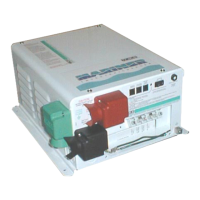)($785(6
&RS\ULJKW7UDFH(QJLQHHULQJ&R,QF 7HOHSKRQH 3DUW1XPEHU
WK
6WUHHW1( )D[ 2FWREHU
$UOLQJWRQ:$86$ ZZZWUDFHHQJLQHHULQJFRP 3DJH
&U\VWDO&RQWUROOHG7LP H%DVH
Proper frequency regulation is assured with the use of a crystal. Battery voltage and power have no
effect on the inverter’s operating frequency.
6WDQGE\%D WWHU\&KDUJHU
The Stand-by feature includes an internal battery charger and automatic transfer relay. This allows
the unit to operate as a battery charger or an inverter (but not at the same time). An external source
of AC power (i.e. shore power or generator) must be supplied to the inverter’s AC input to allow it to
operate as a battery charger. When the unit is operating as a charger its AC output is powered by
the external AC source. See the
Three-Stage Battery Charger
section beginning on Page 56 for an
in-depth description of this charger.
7 UDQVIHU6ZLWFKLQJ6SHHG
While this inverter is not designed specifically to operate as an un-interruptable power supply (UPS),
its transfer time is normally fast enough to hold up computers in the event of a power outage.
Transfer time is a maximum of 32 milliseconds (two 60Hz AC cycles). Success as UPS will vary with
computer models, and cannot be guaranteed. If this is an issue, buy a small, dedicated UPS for the
specific application.
$XWRPD WLF,Q YHUWHUWR& KDUJHU7 UDQVLWLRQ
The inverter automatically becomes a battery charger whenever AC power is supplied to its AC
inputs. There is a minimum 20-second time delay from the time the inverter senses that AC is
present at its input to when the transfer is made. This delay is built in to provide time for a generator
to spin-up to a stable voltage and avoid relay chattering. The inverter’s AC input is internally
connected to the inverter’s AC output while in the battery charger mode. The maximum power that
can be handled by the inverter’s internal wiring and transfer relay is 30 amps.

